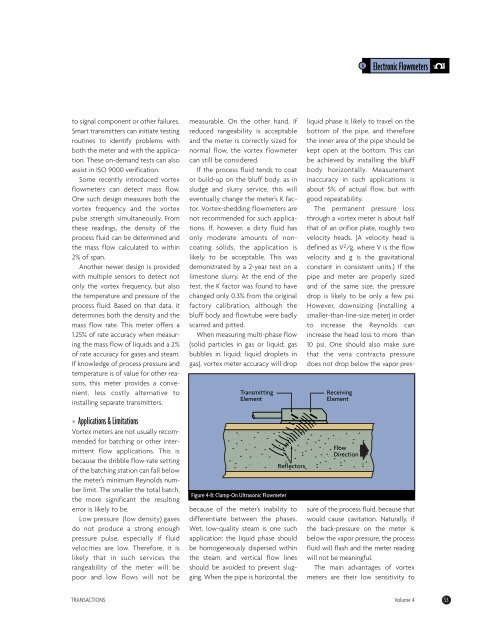flow and level measurement - Omega Engineering
flow and level measurement - Omega Engineering
flow and level measurement - Omega Engineering
You also want an ePaper? Increase the reach of your titles
YUMPU automatically turns print PDFs into web optimized ePapers that Google loves.
to signal component or other failures.<br />
Smart transmitters can initiate testing<br />
routines to identify problems with<br />
both the meter <strong>and</strong> with the application.<br />
These on-dem<strong>and</strong> tests can also<br />
assist in ISO 9000 verification.<br />
Some recently introduced vortex<br />
<strong>flow</strong>meters can detect mass <strong>flow</strong>.<br />
One such design measures both the<br />
vortex frequency <strong>and</strong> the vortex<br />
pulse strength simultaneously. From<br />
these readings, the density of the<br />
process fluid can be determined <strong>and</strong><br />
the mass <strong>flow</strong> calculated to within<br />
2% of span.<br />
Another newer design is provided<br />
with multiple sensors to detect not<br />
only the vortex frequency, but also<br />
the temperature <strong>and</strong> pressure of the<br />
process fluid. Based on that data, it<br />
determines both the density <strong>and</strong> the<br />
mass <strong>flow</strong> rate. This meter offers a<br />
1.25% of rate accuracy when measuring<br />
the mass <strong>flow</strong> of liquids <strong>and</strong> a 2%<br />
of rate accuracy for gases <strong>and</strong> steam.<br />
If knowledge of process pressure <strong>and</strong><br />
temperature is of value for other reasons,<br />
this meter provides a convenient,<br />
less costly alternative to<br />
installing separate transmitters.<br />
• Applications & Limitations<br />
Vortex meters are not usually recommended<br />
for batching or other intermittent<br />
<strong>flow</strong> applications. This is<br />
because the dribble <strong>flow</strong>-rate setting<br />
of the batching station can fall below<br />
the meter’s minimum Reynolds number<br />
limit. The smaller the total batch,<br />
the more significant the resulting<br />
error is likely to be.<br />
Low pressure (low density) gases<br />
do not produce a strong enough<br />
pressure pulse, especially if fluid<br />
velocities are low. Therefore, it is<br />
likely that in such services the<br />
rangeability of the meter will be<br />
poor <strong>and</strong> low <strong>flow</strong>s will not be<br />
measurable. On the other h<strong>and</strong>, if<br />
reduced rangeability is acceptable<br />
<strong>and</strong> the meter is correctly sized for<br />
normal <strong>flow</strong>, the vortex <strong>flow</strong>meter<br />
can still be considered.<br />
If the process fluid tends to coat<br />
or build-up on the bluff body, as in<br />
sludge <strong>and</strong> slurry service, this will<br />
eventually change the meter’s K factor.<br />
Vortex-shedding <strong>flow</strong>meters are<br />
not recommended for such applications.<br />
If, however, a dirty fluid has<br />
only moderate amounts of noncoating<br />
solids, the application is<br />
likely to be acceptable. This was<br />
demonstrated by a 2-year test on a<br />
limestone slurry. At the end of the<br />
test, the K factor was found to have<br />
changed only 0.3% from the original<br />
factory calibration, although the<br />
bluff body <strong>and</strong> <strong>flow</strong>tube were badly<br />
scarred <strong>and</strong> pitted.<br />
When measuring multi-phase <strong>flow</strong><br />
(solid particles in gas or liquid; gas<br />
bubbles in liquid; liquid droplets in<br />
gas), vortex meter accuracy will drop<br />
Transmitting<br />
Element<br />
Figure 4-8: Clamp-On Ultrasonic Flowmeter<br />
Reflectors<br />
because of the meter’s inability to<br />
differentiate between the phases.<br />
Wet, low-quality steam is one such<br />
application: the liquid phase should<br />
be homogeneously dispersed within<br />
the steam, <strong>and</strong> vertical <strong>flow</strong> lines<br />
should be avoided to prevent slugging.<br />
When the pipe is horizontal, the<br />
4 Electronic Flowmeters<br />
liquid phase is likely to travel on the<br />
bottom of the pipe, <strong>and</strong> therefore<br />
the inner area of the pipe should be<br />
kept open at the bottom. This can<br />
be achieved by installing the bluff<br />
body horizontally. Measurement<br />
inaccuracy in such applications is<br />
about 5% of actual <strong>flow</strong>, but with<br />
good repeatability.<br />
The permanent pressure loss<br />
through a vortex meter is about half<br />
that of an orifice plate, roughly two<br />
velocity heads. (A velocity head is<br />
defined as V 2 /g, where V is the <strong>flow</strong><br />
velocity <strong>and</strong> g is the gravitational<br />
constant in consistent units.) If the<br />
pipe <strong>and</strong> meter are properly sized<br />
<strong>and</strong> of the same size, the pressure<br />
drop is likely to be only a few psi.<br />
However, downsizing (installing a<br />
smaller-than-line-size meter) in order<br />
to increase the Reynolds can<br />
increase the head loss to more than<br />
10 psi. One should also make sure<br />
that the vena contracta pressure<br />
does not drop below the vapor pres-<br />
Receiving<br />
Element<br />
Flow<br />
Direction<br />
sure of the process fluid, because that<br />
would cause cavitation. Naturally, if<br />
the back-pressure on the meter is<br />
below the vapor pressure, the process<br />
fluid will flash <strong>and</strong> the meter reading<br />
will not be meaningful.<br />
The main advantages of vortex<br />
meters are their low sensitivity to<br />
TRANSACTIONS Volume 4 53

















